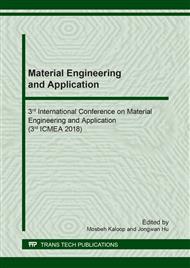[1]
Y. Farag, C. S. Leopold, Phsycochemical Properties of Various Shellac Types, Dissolut. Technol. 45 (2009) 33-39.
Google Scholar
[2]
C. Coelho, R. Nanabala, M. Ménager, S. Commereuc, V. Verney, Molecular changes during natural biopolymer ageing-The case of shellac, Polym. Degrad. Stab. 97 (2012) 936-940.
DOI: 10.1016/j.polymdegradstab.2012.03.024
Google Scholar
[3]
S. Ghoshal, M. A. Khan, F. Gul-E-Noor, R. A. Khan, Gamma Radiation Induced Biodegradable Shellac Films Treated by Acrylic Monomer and Ethylene Glycol, J. Macromol. Sci.- Part A: Pure and Appl. Chem. 46 (2009) 975-982.
DOI: 10.1080/10601320903158594
Google Scholar
[4]
S. A Valencia-Chamorro, M. B. Pérez-Gago, M. del Río, L. Palou, Effect of antifungal hydroxypropyl methylcellulose (HPMC)-lipid edible composite coatings on postharvest decay development and quality attributes of coldstored Valencia' oranges, Postharvest Biol. Technol. 54 (2009).
DOI: 10.1016/j.postharvbio.2009.06.001
Google Scholar
[5]
X. Li, R. C. Vasavada, in: R. C. Rowe, P. J. Sheskey, P. J. Weller (Eds.), Handbook of Pharmaceutical Excipients, Pharmaceutical Press, London, (2003) p.538–540.
Google Scholar
[6]
S. Limmatvapirat, D. Panchapornpon, C. Limmatvapirat, J. Nunthanid, M. Luangtana-Anan, S. Puttipipatkhachorn, Formation of shellac succinate having improved enteric film properties through dry media reaction, Eur. J. Pharm. Biopharm. 70 (2008).
DOI: 10.1016/j.ejpb.2008.03.002
Google Scholar
[7]
S. Limmatvapirat, C. Limmatvapirat, M. Luangtana-anan, J. Nunthanid, T. Oguchi, Y. Tozuka, K. Yamamto, S. Puttipipatkhachorn, Modification of Phsycochemical and Mechanical Properties of Shellac by Hydrolysis Partial, Int. J. Pharm. 278 (2004).
DOI: 10.1016/j.ijpharm.2004.02.030
Google Scholar
[8]
S. Stunner, S. Salar, M. Unger, Application of shellac for the development of probiotic formulations, Food Res. Int. 43 (2010) 1312-1320.
DOI: 10.1016/j.foodres.2010.03.017
Google Scholar
[9]
D. Panchapornpon, C. Limmatvapirat, M. Luangtana-anan, J. Nunthanid, P.Sriamornsak, S. Limmatvapirat, Fabrication of thermally stabilized shellac through solid state reaction with phthalic anhydride, Mater. Lett. 65 (2011) 1241-1244.
DOI: 10.1016/j.matlet.2011.01.068
Google Scholar
[10]
M. Luangtana-anan, S. Limmatvapirat, J. Nunthanid, C. Wanawongthai, R. Chalongsuk, S. Puttipipatkhachorn, Effect of Salts and Plasticizers on Stability of Shellac Film, J. Agric. Food Chem. 55 (2007) 687-692.
DOI: 10.1021/jf061922+
Google Scholar
[11]
R. E. Johnstone, M. W. Thring, Pilot Plants Model and Scale Up Methodes in Chemical Engineering, McGraw-Hill Book Company Inc., New York. (1957) pp.63-73.
DOI: 10.1126/science.126.3275.658.b
Google Scholar
[12]
M. R. Altiokka, A. Citak, Kinetics Study of Esterification of Acetic Acid with Isobutanol in The Presence of Amberlite Catalyst, Appl. Catal. A: General, 239 (2003) 141-148.
DOI: 10.1016/s0926-860x(02)00381-2
Google Scholar


